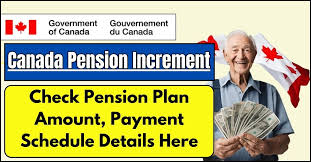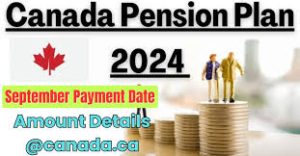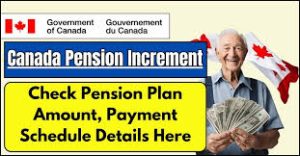Canada Pension Plan payments for September go out soon — Here’s how much you can get


Canada Pension Plan payments for September will be out soon — Here’s how much you can get
The Canada Pension Plan (CPP) is a vital financial support system for millions of Canadians, providing a stable income during retirement, as well as benefits in cases of disability or death. As we move into September, many recipients are anticipating their monthly CPP payments. Here’s what you need to know about the upcoming payments and how much you can expect to receive.
When Are CPP Payments for September 2024 Going Out?
CPP payments are usually disbursed on the third-to-last business day of each month. For September 2024, payments are expected to be issued on September 27. If you’re receiving your payments via direct deposit, they should be available in your account on that day. If you receive your payments by mail, it may take a few additional days for the check to arrive, depending on your location.
How Much Can You Receive?
The amount you receive from CPP depends on several factors, including your age when you start taking your pension, your earnings history, and how much you’ve contributed to the plan during your working years.
As of 2024, the average monthly amount for a new retirement pension is approximately $760, but this can vary widely. The maximum amount you can receive if you start your pension at age 65 is around $1,306.57per month. However, if you choose to start your pension earlier, at age 60, or later, at age 70, these amounts will be adjusted accordingly:
– Early Pension (starting at age 60): Your payments will be reduced by 0.6% for each month you receive your pension before age 65. This means a reduction of up to 36% if you start at age 60.
– Delayed Pension (starting at age 70): Your payments will be increased by 0.7% for each month you delay receiving your pension after age 65, which translates to an increase of up to 42% if you start at age 70.

Additional Benefits
Besides the standard retirement pension, the CPP also offers several other benefits:
– CPP Disability Pension: For those who are unable to work due to a severe and prolonged disability, the CPP disability pension provides financial assistance. The average monthly payment for disability pension recipients is around $1,078.05 as of 2024.
– Survivor’s Pension: If a CPP contributor dies, their surviving spouse or common-law partner may be eligible to receive a survivor’s pension. The amount varies based on the deceased’s contributions and the survivor’s age. The average monthly survivor’s pension is approximately $366.91.
– CPP Post-Retirement Benefits (PRB): If you continue working while receiving your CPP retirement pension, you can still contribute to the CPP and receive additional benefits through the PRB. This is designed to enhance your retirement income even further.

How to Maximize Your CPP Benefits
If you’re nearing retirement age, consider the timing of when you start receiving your CPP payments carefully. Delaying your CPP payments can result in significantly higher monthly benefits, which can be advantageous if you expect to have a long retirement. Additionally, continuing to work and contribute to the CPP even after you start receiving payments can further increase your overall pension through the PRB.
How to Apply for CPP
If you haven’t started receiving CPP yet, you can apply online through the My Service Canada Account. It’s recommended to apply several months before you want your payments to start, as processing times can vary. Make sure to have your Social Insurance Number (SIN) and banking information on hand for direct deposit.
Final Thoughts
The CPP is a cornerstone of retirement planning in Canada, providing financial security for millions of retirees. By understanding how your payments are calculated and the options available, you can make the most out of your CPP benefits. As September approaches, be sure to check your account and ensure everything is in order for your next payment.
If you have any specific questions or need assistance with your CPP, contacting Service Canada directly or visiting their website can provide further guidance.
Positively! Here’s more happy centered around boosting Canada Annuity Plan (CPP) benefits, normal inquiries concerning the arrangement, and how CPP coordinates with other retirement pay sources.
Techniques to Expand Your CPP Advantages
The Canada Benefits Plan is intended to supplant around 25% of your typical lifetime income up to a most extreme yearly pensionable profit limit. Be that as it may, the decisions with respect to when and what you take your CPP advantages can fundamentally mean for your monetary circumstance in retirement. Here are a few procedures to consider:

1. Delay Taking Your CPP Pension
While you can begin getting CPP as soon as age 60, every month you postpone previous age 65 expands your month to month benefits by 0.7%. For example, deferring until age 70 could mean up to 42% more in your regularly scheduled installments. In the event that you have different kinds of revenue and can stand to pause, this can be a savvy move to improve your retirement pay over the long haul.
2. Continue Working and Contributing
Indeed, even in the wake of beginning your CPP annuity, assuming that you keep on working, you can continue to add to CPP until age 70 through the Post-Retirement Advantage (PRB). Each extra year of commitments will build your future regularly scheduled installments. This is especially helpful for the people who could have had lower profit before in their vocation or got some much needed rest for providing care or schooling.
3. Consider Your Wellbeing and Life Expectancy
While postponing CPP can bring about higher month to month benefits, taking into account your wellbeing and family ancestry is significant. On the off chance that you expect a more limited life expectancy because of wellbeing reasons, beginning CPP prior could check out. On the other hand, assuming life span runs in your family, deferring CPP could give more noteworthy lifetime benefits.
4. Integrate CPP with Other Retirement Income
On the off chance that you have other retirement reserve funds, like a RRSP, TFSA, or a work environment benefits, consider how these will cooperate with CPP. For instance, you could draw down your RRSP first to overcome any barrier until you begin getting CPP at age 70, which augments your CPP benefits while protecting your RRSP reserve funds from early consumption.

Normal Inquiries Regarding the CPP
As retirement draws near, numerous Canadians have inquiries concerning how CPP functions. Here are replies to the absolute most normal inquiries:
1. How Is My CPP Sum Calculated?
Your CPP sum is determined in light of your typical profit during your functioning years, your commitments to the CPP, and the age at which you begin getting benefits. Administration Canada utilizes a recipe that incorporates your best 39 years of profit, adapting to expansion, to decide your typical income.
2. Can I Get CPP While Living Abroad?
Indeed, you can accept your CPP installments while living beyond Canada. Nonetheless, you should guarantee that Help Canada has your ongoing location, and you’ll accept your installments through direct store to a Canadian or unfamiliar ledger.
3. How Accomplishes CPP Work with Advanced Age Security (OAS)?
CPP and OAS are discrete projects. While CPP depends on your commitments during your functioning life, OAS is a non-contributory program in view of your long stretches of home in Canada after the age of 18. The two advantages are intended to cooperate to give a fundamental degree of retirement pay. Assuming you are qualified for both, you can get both at the same time.
4. What Happens to My CPP In the event that I Pass Away?
Assuming that you die, your qualified survivors can get benefits from CPP. This incorporates a single amount passing advantage, a survivor’s annuity for your mate or custom-based regulation accomplice, and kids’ advantages for any reliant youngsters. It’s critical to guarantee that your recipients know about these advantages and expertise to apply for them.


How CPP Incorporates with Other Retirement Pay Sources
In Canada, retirement pay normally comes from three principal sources: CPP, OAS, and individual reserve funds (like RRSPs, TFSAs, and work environment annuities). This is the way CPP squeezes into the bigger picture:
1. CPP as a Steady Pay Foundation
CPP turns out a solid revenue base that changes with expansion over the long run. This makes it a fundamental starting point for retirement arranging, assisting with covering your essential everyday costs. Since CPP benefits are intended to last your lifetime, they give genuine serenity, realizing that you’ll have a consistent revenue stream paying little mind to showcase vacillations or speculation execution.
2. OAS as a Supplement
Advanced Age Security (OAS) supplements CPP and is especially significant for retired people who have lower CPP benefits. OAS is accessible to most Canadians matured 65 and more seasoned, and the not set in stone by your long periods of home in Canada. Higher-pay seniors might have their OAS benefits ripped at back through the OAS recuperation charge, so it’s fundamental to think about this while arranging your retirement pay.
3. RRSPs and TFSAs for Flexibility
Enlisted Retirement Reserve funds Plans (RRSPs) and Tax-Exempt Bank accounts (TFSAs) offer adaptability in retirement. You can draw on these records on a case by case basis, which permits you to control the timing and measure of your withdrawals. This can be especially helpful for dealing with your annual duty section and guaranteeing you have sufficient pay in years where different sources, as CPP and OAS, may not cover every one of your costs.
4. Employer Pensions
In the event that you have a working environment benefits, this will ordinarily frame a critical piece of your retirement pay. Characterized benefit annuities turn out unsurprising revenue, while characterized commitment plans rely upon the presentation of the ventures. Understanding how your manager annuity incorporates with CPP can assist you with settling on informed conclusions about when to begin each advantage.

Last Contemplations
As you approach retirement, it’s vital to take an all encompassing perspective on the entirety of your pay sources. A monetary counsel can assist you with delineating a methodology that improves your CPP benefits, limits burdens, and guarantees you have a steady and adequate pay all through your retirement years.
Keep in mind, while CPP is a significant piece of your retirement pay, it’s only one piece of the riddle. Preparing and understanding how CPP squeezes into your more extensive retirement technique will assist you with partaking in a more agreeable and monetarily secure retirement.
Certainly! Here’s additional content focused on practical tips for managing CPP benefits, the impact of CPP enhancements, and the importance of staying informed about CPP changes.
Practical Tips for Managing Your CPP Benefits
Effectively managing your Canada Pension Plan (CPP) benefits can make a significant difference in your retirement lifestyle. Here are some practical tips to help you maximize and manage your CPP benefits:
1. Review Your CPP Contributions Regularly
It’s important to keep track of your CPP contributions throughout your working life. You can check your CPP Statement of Contributions through your **My Service Canada Account**. This statement provides a record of your pensionable earnings and the contributions you and your employers have made to the plan. Regularly reviewing this statement ensures that there are no gaps or inaccuracies in your record, which could affect your retirement benefits.
2. Consider the Dropout Provisions
CPP includes dropout provisions that can help increase your benefits by excluding certain low-earning periods from the calculation of your pensionable earnings. These provisions include the **Child Rearing Dropout** (which allows parents to exclude years of low or no earnings while raising young children) and the General Dropout Provision (which excludes your lowest-earning 8 years from the calculation). If you’ve had periods of lower income, understanding these provisions can help you maximize your CPP payments.
3. Budget for Taxes on CPP Income
While CPP payments provide essential retirement income, they are considered taxable income. Depending on your total income in retirement, you might need to pay taxes on your CPP benefits. It’s a good idea to set aside a portion of your CPP income for taxes or request that Service Canada withhold tax at source to avoid a large tax bill at the end of the year.
4. Coordinate with Your Spouse or Partner
If you’re married or in a common-law partnership, coordinating the timing of your CPP benefits with your spouse can be advantageous. For example, if one partner has a significantly higher CPP entitlement, you might delay their benefits to maximize the payout while the other partner starts their benefits earlier. Additionally, pension sharing is an option where you and your spouse can share your CPP benefits to reduce your overall tax burden.
Understanding the Impact of CPP Enhancements
In recent years, the Canadian government has introduced enhancements to the CPP to provide more robust support for retirees. Understanding these enhancements is crucial for those planning their retirement:
1. Gradual Increase in Contributions
Starting in 2019, CPP contributions have gradually increased to fund enhanced benefits. By 2025, contribution rates will rise from 4.95% to 5.95% for employees and a matching increase for employers. This means that during your working years, you’ll contribute more, but these contributions will result in higher benefits when you retire.
2. Higher Replacement Rate
The CPP enhancements aim to increase the income replacement rate from 25% to 33% of your average work earnings. This means that in the future, new retirees will receive a higher percentage of their pre-retirement income from CPP than under the previous rules. This enhancement is particularly beneficial for younger workers, as their full working career will be covered under the enhanced CPP.
3. Additional Yearly Maximum Pensionable Earnings (YMPE)
The Yearly Maximum Pensionable Earnings (YMPE) is the maximum amount of earnings on which you contribute to the CPP. As part of the enhancements, the YMPE will increase, allowing higher earners to contribute more and subsequently receive larger benefits. Starting in 2024, there will be a new upper limit, 14% above the existing YMPE, known as the Additional Maximum Pensionable Earnings (AMPE).
Staying Informed About CPP Changes
The CPP is an evolving program, with changes and updates that can affect your retirement planning. Staying informed is key to making the best decisions regarding your benefits. Here’s how to keep up-to-date:
1. Monitor Government Announcements
Major changes to CPP are typically announced by the federal government. Following these announcements can help you stay informed about new benefits, contribution rate adjustments, or other significant changes that might impact your retirement planning.
2. Consult Financial Advisors
Financial advisors can provide tailored advice based on the latest CPP regulations and how they apply to your unique situation. They can help you navigate complex decisions, such as when to start your benefits, how to minimize taxes, and how to integrate CPP with other retirement income sources.
3. Utilize Online Resources
Websites like the Canada Pension Plan section on the Government of Canada’s site, along with tools available through **My Service Canada Account**, offer valuable information. These resources can help you estimate your future benefits, apply for CPP, and understand how different factors will affect your payments.
4. Attend Retirement Planning Seminars
Many community organizations, employers, and financial institutions offer seminars or webinars on retirement planning, including how to maximize your CPP benefits. These events can provide valuable insights and give you a chance to ask questions directly to experts.
The Importance of CPP in Your Retirement Plan
The Canada Pension Plan plays a critical role in your overall retirement strategy. For many Canadians, it represents a stable, inflation-adjusted income that can cover a significant portion of their retirement expenses. However, the effectiveness of CPP as a retirement tool depends on how well you understand and manage it:
– CPP as a Lifelong Benefit: Unlike personal savings or investments that can be depleted, CPP is a guaranteed lifetime benefit. This makes it a valuable resource for ensuring you don’t outlive your retirement savings.
– CPP and Inflation Protection: CPP payments are indexed to inflation, which helps maintain your purchasing power as costs rise over time. This feature is especially important in long retirements, where inflation can erode the value of fixed income sources.
– Balancing Risk with CPP: In a retirement portfolio, CPP can be seen as the “safe” component, balancing the riskier aspects of your investments. Knowing that a portion of your income is secure can give you more confidence in making other investment decisions.
Conclusion
The Canada Pension Plan is a foundational element of retirement security for millions of Canadians. By understanding how it works, staying informed about enhancements and changes, and integrating it wisely with other income sources, you can maximize the benefits CPP offers. Whether you are years away from retirement or already receiving benefits, taking a proactive approach to managing your CPP will help ensure a more comfortable and financially secure retirement.
Sure! We should plunge further into cutting edge CPP arranging techniques, contemplations for various life stages, and the job of CPP in monetary making arrangements for explicit situations like withdrawal from the workforce, seasonal work, and changing out of the labor force.
High level CPP Arranging Systems
For the people who need to enhance each part of their retirement arranging, high level systems around the Canada Benefits Plan (CPP) can have a huge effect. Here are a few modern ways to deal with consider:
1. Pension Sharing for Expense Optimization
On the off chance that you and your companion are both qualified for CPP, annuity sharing can be an expense effective methodology. This permits you to part your CPP pay with your mate, which can bring down your joined available pay and possibly diminish your general expense responsibility. This is especially helpful in the event that one accomplice is in a higher expense section than the other. While benefits sharing doesn’t change the complete advantages got as a team, it can bring about huge expense reserve funds, particularly in retirement.
2. Leveraging CPP in Early Retirement
For those considering exiting the workforce, the choice of when to begin CPP is critical. Beginning at age 60 accompanies a decrease in benefits, yet this may be balanced by other retirement pay or reserve funds. An essential methodology is to utilize individual reserve funds, similar to a RRSP, to overcome any barrier between exiting the workforce and when you begin taking CPP at a later age, preferably more like 65 or even 70. This permits you to defer CPP and get a higher month to month benefit, while dealing with your general retirement pay all the more successfully.
3. CPP Credit Parting After Divorce
In case of a separation or division, CPP credit parting is a significant thought. This interaction separates the CPP commitments made by the two mates during their marriage or precedent-based regulation association. While this can decrease the CPP advantage of the greater procuring mate, it guarantees that the lower-acquiring life partner gets a decent amount of the benefits commitments, which can essentially further develop their retirement pay. Understanding the guidelines around credit parting and what it means for your CPP is basic during divorce discussions.
4. Integrating CPP with Corporate Pensions
On the off chance that you have a characterized benefit (DB) or characterized commitment (DC) annuity plan through your manager, planning when you start CPP can assist you with streamlining your retirement pay. Some DB plans are incorporated with CPP, implying that the arrangement’s installments will diminish or “span” when you begin getting CPP. In these cases, postponing CPP might bring about a lower complete pay, so understanding how your boss’ benefits cooperates with CPP is fundamental.
CPP Contemplations for Various Life Stages
Your way to deal with CPP ought to develop as you travel through various phases of life. This is the way to ponder CPP at different places in your profession and retirement venture:
1. Early Vocation (20s and 30s)
While retirement might appear to be far not entirely OK in your initial profession, the choices you make presently can affect your CPP benefits. Guaranteeing predictable commitments through stable job is urgent. Holes in work, particularly on the off chance that they happen from the get-go in your vocation, can lessen your typical profit and lower your CPP benefits. Putting resources into your vocation and looking for higher profit will add to a more strong CPP payout in retirement.
2. Mid-Vocation (40s and 50s)
As you approach your pinnacle procuring years, it means quite a bit to zero in on expanding your CPP commitments. This is likewise a great opportunity to begin contemplating when you need to resign and how CPP squeezes into your retirement methodology. In the event that you’ve gotten some much needed rest work for bringing up youngsters or different reasons, investigate the dropout arrangements accessible, similar to the Kid Raising Dropout, to guarantee these periods don’t adversely influence your CPP benefits.
3. Late Vocation (50s and 60s)
In your late vocation, you ought to start making more substantial arrangements for when and how to begin your CPP. Consider the monetary and individual ramifications of resigning early as opposed to proceeding to work and conceivably deferring your CPP. Audit your CPP explanation routinely to comprehend what you can expect and whether it lines up with your retirement objectives. Also, consider the effect of proceeding to work subsequent to beginning CPP, which could incorporate making extra commitments through the Post-Retirement Advantage (PRB).
4. Post-Retirement (65+)
Whenever you’re resigned, dealing with your CPP related to other pay sources turns into your essential concentration. On the off chance that you’re working parttime, keep adding to the CPP to support your pay through the PRB. Screen expansion changes in accordance with your CPP installments, and guarantee that your CPP is being burdened properly to keep away from shocks at charge time. In the event that your conditions change, for example, losing a mate, investigate survivor advantages to guarantee you’re getting all entitled advantages.
CPP in Unambiguous Retirement Situations
Different retirement situations require fitted ways to deal with CPP. This is the way to oversee CPP in a few normal however extraordinary circumstances:
1. Early Retirement
Resigning early — before 65 — frequently implies depending on private reserve funds or boss annuities until CPP kicks in. Assuming that you resign at 60, beginning CPP promptly will lessen your month to month benefits by up to 36%. To stay away from this decrease, think about drawing on RRSPs or different reserve funds first, permitting you to defer CPP and benefit from higher installments later. Adjusting your portfolio to create pay in the early long stretches of retirement can make this procedure practical.
2. Part-Time Work in Retirement
Assuming you intend to work parttime after retirement, organizing your CPP with this pay is vital. Assuming you’re under 70, you’re actually expected to add to CPP from your business pay, which will go towards the PRB. This can build your CPP benefits, giving an extra stream of pay close by your seasonal work. Cautiously think about the duty ramifications of joining CPP with business pay and investigate benefits imparting to your companion to limit charges.
3. Transitioning Out of the Workforce
For those sliding into retirement by bit by bit decreasing work hours, timing the beginning of your CPP is critical. You could choose to begin CPP when you decrease your hours, or defer it assuming your pay is adequate. In the event that changing to full retirement, ensure your CPP, business annuities, and reserve funds adjust to turn out the revenue you really want. It’s additionally a valuable chance to reevaluate your monetary arrangement and guarantee that it upholds your way of life and long haul objectives.
Remaining Proactive with CPP Updates and Assets
To take advantage of CPP, remaining proactive is fundamental. The public authority intermittently refreshes CPP rules, improvements, and rates, and these can affect your retirement arranging:
– Yearly CPP Statements: Solicitation and audit your CPP articulation yearly to follow your commitments and projected benefits. This assists you with remaining informed about your normal retirement pay and change your investment funds or retirement designs as needs be.
– Government and Monetary Counselor Consultations: Consistently talk with a monetary guide who can give customized exhortation in view of the most recent CPP rules and how they coordinate with your by and large monetary arrangement. The public authority’s assets and updates on the CPP site are likewise significant for remaining informed.
-Think about Existence Changes**: Life altering situations like marriage, separate, or the introduction of a kid can influence your CPP benefits. Refreshing your CPP data and understanding what these progressions mean for your advantages guarantees you don’t pass up qualifications like the Kid Raising Dropout or survivor benefits.
End
Boosting your CPP benefits requires a mix of informed direction, key preparation, and an intensive comprehension of how the arrangement incorporates with other retirement pay sources. Whether you’re from the get-go in your profession or approaching retirement, each stage presents special chances to upgrade your CPP. By remaining informed about the most recent changes, organizing with other retirement pay, and taking into account your own conditions, you can make CPP a useful asset in getting a familiar and monetarily stable retirement.
Sure! We should plunge further into cutting edge CPP arranging techniques, contemplations for various life stages, and the job of CPP in monetary making arrangements for explicit situations like withdrawal from the workforce, seasonal work, and changing out of the labor force.
High level CPP Arranging Systems
For the people who need to enhance each part of their retirement arranging, high level systems around the Canada Benefits Plan (CPP) can have a huge effect. Here are a few modern ways to deal with consider:
1. Pension Sharing for Expense Optimization
On the off chance that you and your companion are both qualified for CPP, annuity sharing can be an expense effective methodology. This permits you to part your CPP pay with your mate, which can bring down your joined available pay and possibly diminish your general expense responsibility. This is especially helpful in the event that one accomplice is in a higher expense section than the other. While benefits sharing doesn’t change the complete advantages got as a team, it can bring about huge expense reserve funds, particularly in retirement.
2. Leveraging CPP in Early Retirement
For those considering exiting the workforce, the choice of when to begin CPP is critical. Beginning at age 60 accompanies a decrease in benefits, yet this may be balanced by other retirement pay or reserve funds. An essential methodology is to utilize individual reserve funds, similar to a RRSP, to overcome any barrier between exiting the workforce and when you begin taking CPP at a later age, preferably more like 65 or even 70. This permits you to defer CPP and get a higher month to month benefit, while dealing with your general retirement pay all the more successfully.
3. CPP Credit Parting After Divorce
In case of a separation or division, CPP credit parting is a significant thought. This interaction separates the CPP commitments made by the two mates during their marriage or precedent-based regulation association. While this can decrease the CPP advantage of the greater procuring mate, it guarantees that the lower-acquiring life partner gets a decent amount of the benefits commitments, which can essentially further develop their retirement pay. Understanding the guidelines around credit parting and what it means for your CPP is basic during divorce discussions.
4. Integrating CPP with Corporate Pensions
On the off chance that you have a characterized benefit (DB) or characterized commitment (DC) annuity plan through your manager, planning when you start CPP can assist you with streamlining your retirement pay. Some DB plans are incorporated with CPP, implying that the arrangement’s installments will diminish or “span” when you begin getting CPP. In these cases, postponing CPP might bring about a lower complete pay, so understanding how your boss’ benefits cooperates with CPP is fundamental.
CPP Contemplations for Various Life Stages
Your way to deal with CPP ought to develop as you travel through various phases of life. This is the way to ponder CPP at different places in your profession and retirement venture:
1. Early Vocation (20s and 30s)
While retirement might appear to be far not entirely OK in your initial profession, the choices you make presently can affect your CPP benefits. Guaranteeing predictable commitments through stable job is urgent. Holes in work, particularly on the off chance that they happen from the get-go in your vocation, can lessen your typical profit and lower your CPP benefits. Putting resources into your vocation and looking for higher profit will add to a more strong CPP payout in retirement.
2. Mid-Vocation (40s and 50s)
As you approach your pinnacle procuring years, it means quite a bit to zero in on expanding your CPP commitments. This is likewise a great opportunity to begin contemplating when you need to resign and how CPP squeezes into your retirement methodology. In the event that you’ve gotten some much needed rest work for bringing up youngsters or different reasons, investigate the dropout arrangements accessible, similar to the Kid Raising Dropout, to guarantee these periods don’t adversely influence your CPP benefits.
3. Late Vocation (50s and 60s)
In your late vocation, you ought to start making more substantial arrangements for when and how to begin your CPP. Consider the monetary and individual ramifications of resigning early as opposed to proceeding to work and conceivably deferring your CPP. Audit your CPP explanation routinely to comprehend what you can expect and whether it lines up with your retirement objectives. Also, consider the effect of proceeding to work subsequent to beginning CPP, which could incorporate making extra commitments through the Post-Retirement Advantage (PRB).
4. Post-Retirement (65+)
Whenever you’re resigned, dealing with your CPP related to other pay sources turns into your essential concentration. On the off chance that you’re working parttime, keep adding to the CPP to support your pay through the PRB. Screen expansion changes in accordance with your CPP installments, and guarantee that your CPP is being burdened properly to keep away from shocks at charge time. In the event that your conditions change, for example, losing a mate, investigate survivor advantages to guarantee you’re getting all entitled advantages.
CPP in Unambiguous Retirement Situations
Different retirement situations require fitted ways to deal with CPP. This is the way to oversee CPP in a few normal however extraordinary circumstances:
1. Early Retirement
Resigning early — before 65 — frequently implies depending on private reserve funds or boss annuities until CPP kicks in. Assuming that you resign at 60, beginning CPP promptly will lessen your month to month benefits by up to 36%. To stay away from this decrease, think about drawing on RRSPs or different reserve funds first, permitting you to defer CPP and benefit from higher installments later. Adjusting your portfolio to create pay in the early long stretches of retirement can make this procedure practical.
2. Part-Time Work in Retirement
Assuming you intend to work parttime after retirement, organizing your CPP with this pay is vital. Assuming you’re under 70, you’re actually expected to add to CPP from your business pay, which will go towards the PRB. This can build your CPP benefits, giving an extra stream of pay close by your seasonal work. Cautiously think about the duty ramifications of joining CPP with business pay and investigate benefits imparting to your companion to limit charges.
3. Transitioning Out of the Workforce
For those sliding into retirement by bit by bit decreasing work hours, timing the beginning of your CPP is critical. You could choose to begin CPP when you decrease your hours, or defer it assuming your pay is adequate. In the event that changing to full retirement, ensure your CPP, business annuities, and reserve funds adjust to turn out the revenue you really want. It’s additionally a valuable chance to reevaluate your monetary arrangement and guarantee that it upholds your way of life and long haul objectives.
Remaining Proactive with CPP Updates and Assets
To take advantage of CPP, remaining proactive is fundamental. The public authority intermittently refreshes CPP rules, improvements, and rates, and these can affect your retirement arranging:
– Yearly CPP Statements: Solicitation and audit your CPP articulation yearly to follow your commitments and projected benefits. This assists you with remaining informed about your normal retirement pay and change your investment funds or retirement designs as needs be.
– Government and Monetary Counselor Consultations: Consistently talk with a monetary guide who can give customized exhortation in view of the most recent CPP rules and how they coordinate with your by and large monetary arrangement. The public authority’s assets and updates on the CPP site are likewise significant for remaining informed.
– Think about Existence Changes: Life altering situations like marriage, separate, or the introduction of a kid can influence your CPP benefits. Refreshing your CPP data and understanding what these progressions mean for your advantages guarantees you don’t pass up qualifications like the Kid Raising Dropout or survivor benefits.
End
Boosting your CPP benefits requires a mix of informed direction, key preparation, and an intensive comprehension of how the arrangement incorporates with other retirement pay sources. Whether you’re from the get-go in your profession or approaching retirement, each stage presents special chances to upgrade your CPP. By remaining informed about the most recent changes, organizing with other retirement pay, and taking into account your own conditions, you can make CPP a useful asset in getting a familiar and monetarily stable retirement.
Let’s explore more complex and higher-level strategies, including the role of CPP in estate planning, the implications of CPP in a high-net-worth retirement strategy, and how advanced tax planning can optimize your overall retirement income, including CPP.
Advanced CPP Strategies for High-Net-Worth Individuals
High-net-worth individuals often have a more complex financial picture, and the Canada Pension Plan (CPP) may seem like a small piece of the puzzle. However, strategic planning around CPP can still add value, particularly when integrated with other wealth management strategies.
1. CPP and Estate Planning
For high-net-worth individuals, CPP is not just about retirement income—it also plays a role in estate planning. While CPP benefits are not directly inheritable, there are survivor benefits that can be valuable for a spouse or dependent children. To maximize these benefits:
– Survivor Pension Strategy: Ensure that your spouse or common-law partner is aware of the survivor pension available to them. This is particularly important if there’s a significant age difference between partners or if one partner has limited personal retirement savings.
– Structuring Spousal Retirement: If both spouses are entitled to CPP, consider coordinating the timing of their benefits to optimize survivor benefits. For instance, one partner might delay CPP to maximize the survivor pension should they predecease their spouse.
– Legacy Planning: Although CPP itself doesn’t pass on to heirs, ensuring your overall retirement income strategy—including CPP—leaves room for wealth transfer can be crucial. By maximizing CPP, you may reduce the need to draw down other assets, preserving more of your estate for heirs.
2. CPP in a High-Income Retirement Strategy
For high-net-worth individuals, CPP is a relatively small portion of retirement income, but it still requires careful integration with other sources of income:
– Tax Considerations: CPP payments are fully taxable, and for high-net-worth individuals, this income may push you into a higher tax bracket. Advanced tax planning strategies, such as income splitting with a spouse, can help mitigate the tax impact of CPP.
– Strategic Deferral : Consider deferring CPP to age 70, even if you have ample retirement savings. The increased monthly benefit can serve as a hedge against longevity risk, ensuring a guaranteed income stream later in life. This can complement other income sources that may be more market-sensitive.
– Integrating with Private Pensions: High-net-worth retirees often have significant private pension income. Ensuring that CPP integrates smoothly with these pensions—especially in terms of timing—can optimize overall cash flow and tax efficiency.
3. Using CPP in Tax Planning
For high-net-worth individuals, advanced tax planning is essential, and CPP should be factored into this:
– Pension Sharing: While the total CPP benefit for a couple remains the same, pension sharing can lower the couple’s overall tax bill by splitting the income between spouses. This is especially beneficial if one spouse is in a significantly lower tax bracket.
– Post-Retirement Benefits (PRB): If you continue to work past the age of 65, you must continue contributing to CPP unless you opt out. These contributions increase your CPP payments through the PRB, which is also taxable but can be a useful addition to your income strategy. Carefully planning when and how to take advantage of the PRB can optimize your tax situation.
– CPP and Charitable Giving: High-net-worth retirees often incorporate charitable giving into their financial plans. Since CPP is taxable income, consider using it to fund charitable donations, which can generate tax credits that offset the taxes owed on your CPP payments.
CPP in Complex Family Situations
For high-net-worth families, complex dynamics such as blended families, children from previous marriages, or dependents with special needs require a nuanced approach to retirement and estate planning, including the integration of CPP.
1. Blended Families and CPP Survivor Benefits
Blended families often present unique challenges in estate planning. Ensuring that CPP survivor benefits are maximized and directed to the intended beneficiaries is crucial:
– Designating Beneficiaries: While CPP survivor benefits are typically straightforward, in complex family situations, ensure that your wishes regarding who should receive these benefits are clearly documented. This might involve working closely with legal and financial advisors to structure your estate and beneficiary designations appropriately.
– Coordinating With Spousal Support: If you have obligations for spousal support following a divorce, it’s essential to consider how CPP will interact with these payments. Coordinating the timing of your CPP benefits with your support obligations can help manage cash flow and tax implications.
2. Dependents with Special Needs
If you have dependents with special needs, ensuring their financial security is a top priority. CPP can play a role in this:
– CPP Disability Pension: If a dependent child is disabled, they may be eligible for the CPP Children’s Benefit if you, the parent, are receiving a CPP disability pension. This additional income can be invaluable for covering the costs associated with care.
– Trust Planning: High-net-worth individuals often establish trusts for dependents with special needs. Integrating CPP benefits into these plans ensures that the dependent’s income needs are met without jeopardizing eligibility for other forms of assistance. Proper structuring of the trust can help balance these needs while optimizing tax efficiency.
CPP as Part of a Broader Wealth Management Strategy
For those with significant assets, CPP is a relatively small part of the financial picture, but it still plays an essential role in the broader context of wealth management.
1. Longevity Risk Mitigation
Even high-net-worth individuals need to consider longevity risk—the possibility of outliving their assets. CPP provides a guaranteed, inflation-adjusted income stream for life, making it a valuable component of a retirement strategy designed to last over potentially several decades.
– Asset Allocation: By maximizing CPP through deferral and other strategies, you can afford to allocate more of your investment portfolio to growth-oriented assets. This strategy balances the safety of guaranteed CPP income with the potential for higher returns from your investments.
– Sequence of Returns Risk: Retirees face the risk that poor investment returns early in retirement could deplete their savings faster than expected. A robust CPP benefit, maximized through deferral or strategic planning, provides a buffer against this risk, allowing your other assets more time to recover from market downturns.
2. Integrating CPP with Global Assets
High-net-worth individuals often have assets and income streams in multiple countries. Integrating CPP into this complex financial landscape requires careful planning:
– Tax Residency Considerations: If you plan to retire abroad, the tax treatment of CPP payments in your country of residence is critical. Some countries have tax treaties with Canada that affect how your CPP is taxed. Understanding these rules can help you avoid double taxation and optimize your global income strategy.
– Foreign Exchange Risk: For retirees living outside of Canada, CPP benefits are paid in Canadian dollars. If you live in a country with a different currency, fluctuations in exchange rates can impact your effective CPP income. Consider strategies to hedge against this risk, such as holding investments in Canadian dollars or using financial products designed to protect against currency fluctuations.
Conclusion: CPP in a High-Level Financial Strategy
For high-net-worth individuals, CPP may not be the largest component of retirement income, but it plays a critical role in a well-rounded financial strategy. By understanding how CPP integrates with other income sources, estate planning, and global financial considerations, you can optimize your overall retirement and wealth management strategy.
The key to maximizing CPP lies in advanced planning and integration with broader financial goals. Whether it’s deferring benefits to hedge against longevity risk, leveraging tax strategies to minimize liabilities, or incorporating CPP into a global asset structure, a strategic approach to CPP can enhance the financial security and efficiency of even the most sophisticated retirement plans.
SOURCE:CANADIANHUB.TECH


